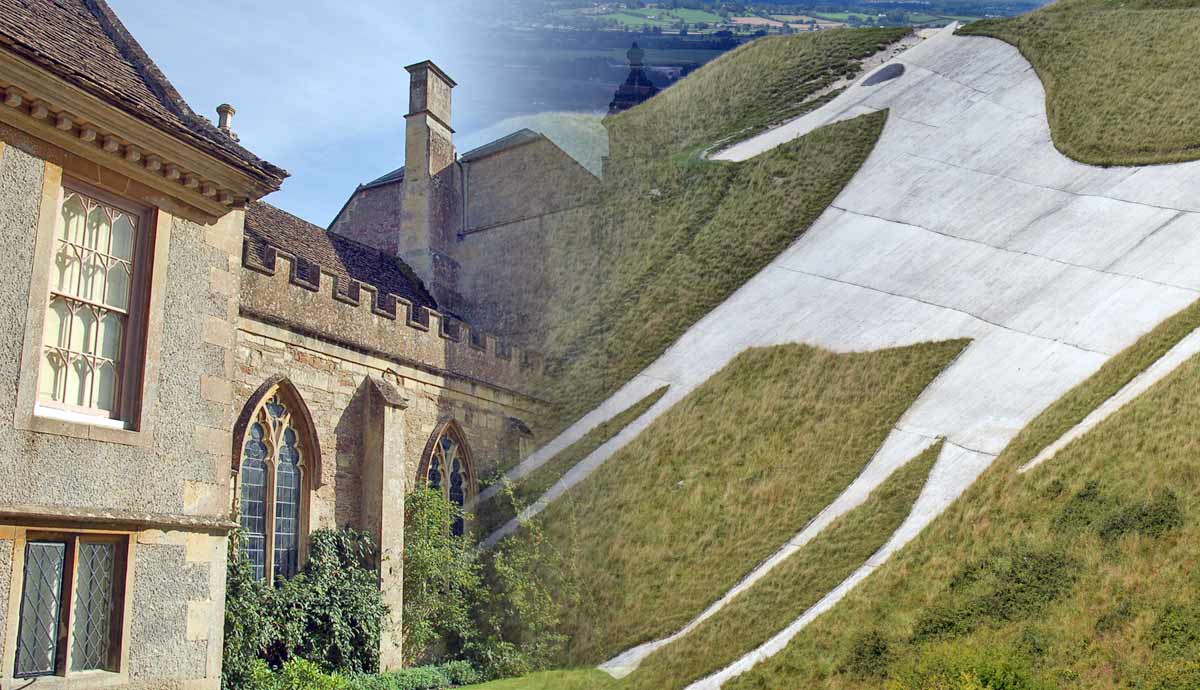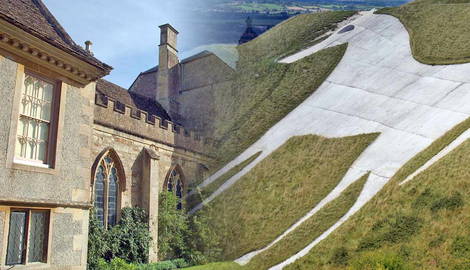
Wiltshire’s iconic white horse can be seen from miles away, but it is not the only fabulous piece of history to be found in the English county. Discover the Devil’s Den, a sealed Neolithic burial tomb, and Silbury Hill, a mound as large as it is confusing to experts who cannot determine why it was built. Walk the halls of a 500-year-old abbey and tread the ruins of a medieval royal castle and cathedral at Old Sarum. These are the best historical places to visit in Wiltshire.
1. Gaze in Wonder at the Obscure & Mystical Silbury Hill

The largest prehistoric mound in Europe, this man-made structure was probably built between 2470 and 2350 BCE. Although it is similar in appearance, volume, and height to contemporary pyramids in Egypt, no evidence of burials has been found in Silbury Hill. It is estimated to be the product of some 4 million hours of work and 500,000 tons of material. The mound, which mostly consists of chalk and soil, was gradually built up over time, starting from just a small pile of gravel around one meter high that was placed on ground that had previously been stripped of its topsoil.
Despite various best guesses, experts can’t be sure as to the purpose of Silbury Hill or the cause of its initial establishment and expansive construction. In its later stages, a ring of stakes was used to mark out a larger area, and more natural materials, including items like large boulders, were added. An enclosing ditch was later constructed, spanning 100 meters in diameter. The ditch was repeatedly backfilled and re-cut. Excavation attempts in recent centuries have resulted in the digging of three separate tunnels to the center of the mound. Although these were then filled, extensive damage was caused by this method of excavation. Subsequently, less invasive approaches have been pursued as historians continue to question the motive behind Silbury Hill.
2. Walk Alongside Neolithic Chambered Tombs at West Kennet Long Barrow

Close to Silbury Hill is another Neolithic archaeological site containing chambered tombs. West Kennet Long Barrow is a burial site with the remains of 46 individuals identified among a mixture of cremations and burials. The site was built around 3650 BCE in two phases, indicated by a subtle direction change halfway along its longest side. Along with human remains, additional items dating from 3000 and 2600 BCE have also been recovered. These include a dagger, beads, and some pottery. It seems that after the burial of these 46 individuals, the tomb was filled with stones and earth to close it off. Sarsen boulders were used to block the forecourt, create a false entrance, and block the entrance to the tomb.
This site offers a fascinating perspective of Neolithic life. Today, it is possible to walk alongside the 100-meter barrow and enter its chamber. Silbury Hill can be seen in the distance, making it easy to imagine how one might be standing in the heart of a bustling Neolithic settlement, where people worked hard to build burial mounds, position great boulders, and shape the land to reflect their presence.
3. Discover Renaissance-Inspired Splendor at Lacock Abbey

Lacock Abbey has over 800 years of history, starting out as grounds for a nunnery, founded in 1232 by Ela, Countess of Salisbury. The countess was a powerful woman, and although her medieval cloister was demolished in the 15th century, plenty of medieval monastic architecture can be seen in the rooms of the abbey. Following the Dissolution of the Monasteries, a Tudor courtier purchased the abbey and transformed it into his country home. He added an octagonal tower, among other adaptations, all inspired by Italian-influenced Renaissance architecture.
In 1714, Lacock Abbey passed to John Ivory Talbot, who, with the help of architect Sanderson Miller, imprinted his Gothic preferences onto various parts of the property, including the Great Hall and the entrance arch. In 1835, William Henry Fox Talbot captured the first photographic negative, a remarkable moment in the history of photography. In 1916, Matilda Talbot inherited the estate and would later sell parts of the estate’s collection to fund improvements to her tenants’ properties before gifting the Lacock estate to the National Trust in 1944. Today, it is possible to visit Lacock Abbey and explore the centuries of history guarded in its design and furnishings.
4. Stand Where Ancient Battles Were Won & Lost at Barbury Hill Iron Age Fort

Barbury Hill Iron Age Fort, or “Barbury Castle,” has a history spanning 2,500 years, including a period of Roman conquest and occupation. A double ditch set just below the hilltop was only passable by entrances on the east and west sides of the fort. Excavations have revealed storage pits and huts, along with chariot fittings and jewelry. With its excellent vantage point, the hillfort provided a strategic edge to those in situ. It was here in the Battle of Beran Byrig or “Beranburh” that Cynric, King of Wessex between 534 and 560, defeated the Britons in 556 CE.
During World War II (1939-1945), the US Army Air Force used the area to position several anti-aircraft guns. Although no artillery remains, it is thought that hollows indicate where the weaponry once stood around the fort’s interior. It is also now known that 40 Iron Age hut circles once stood within the castle walls, revealed only by a geophysical survey completed in 1996. These huts would have been built with low wooden wall posts, supporting lintels, a wattle, and a roof brace. Atop these features, rafters were laid, with one end fixed to the low wall posts and the other joined at the top. Purlins were then added, horizontally wrapping around the roof, before a thick thatch was installed to keep out the wind and rain. Visitors can walk around the site and learn more about the history of Barbury Hill.
5. Visit the Devil’s Den, Where Folklore Tells Tales of a Demon Who Drinks From the Stone

Another prominent Neolithic burial chamber can be found on Fyfield Hill. The Devil’s Den is a dolmen-type burial chamber constructed with the help of standing stones and a capstone. The large stones mark entrances to long chambers, where community members were able to walk inside and lay their friends and families to rest. Although these stones mark the entrance to a 70-meter-long Neolithic passage grave, the tomb is inaccessible. Many of these chambers reveal cremated and buried remains, along with various items associated with burial rituals.
Today, the Devil’s Den stones have fallen out of place and would have looked quite different when first erected. Still, with two standing stones, two fallen stones, and a capstone, this monument is quite striking. The Devil’s Den likely got its name from the growing presence of Christianity in England. Pagans were encouraged to be wary of the devil, abandon their Pagan ways, and instead follow the “true faith.” Local lore says an individual can draw out a demon at night to the Devil’s Den by pouring water into the capstone hollows. This will entice the demon to come and drink from the stone in the darkness of night.
6. Roam the Ruins of Old Sarum, Where a Cathedral & Castle Once Stood

At Old Sarum, the grounds are littered with ruins from a medieval cathedral, a medieval royal castle, and an Iron Age Fort, thought to have been built in 400 BCE. Following the Roman conquest of Britain in 43 CE, the fort was renamed “Sorviodunum.” A lack of records makes it difficult to understand precisely how the fort and surrounding settlements may have looked and how their use may have evolved over the centuries, but evidence of Anglo-Saxon and Roman activity is very much present.
Following the Norman conquest of 1066, a motte and bailey was built, no doubt housing many of William the Conqueror’s soldiers at what was a strategically advantageous location for the invaders. Along with living quarters, halls, and towers, a cathedral was constructed inside the castle grounds, setting the foundations for Old Sarum to become a power hub for various governmental and ecclesial authorities. The cathedral would eventually be moved, although Old Sarum, now considered a “rotten borough” as it had much fewer voters but equal voting power compared to other boroughs, continued to elect members into Parliament until 1832. Today, it is possible to discover the history of the area via the information boards spread about the ruins.
7. Ramble Over the Hills to See the White Horse at Bratton Camp

In 878, King Alfred defeated the Danish King Guthrum and his Great Heathen Army at the Battle of Ethandun. Several centuries later, in the 17th century, a white horse was carved into the hill face of the chalk grasslands to mark Alfred the Great’s victory. This seemingly odd turn of events was not uncommon. Stories of Saxon’s defeating pagan Danes atop white horses led to an increasingly popular practice at this time: the carving of white horses into the hillsides. Many believed they had the Saxons to thank for bringing Christianity to their lands.

The geoglyph was later destroyed, and in 1778, a new horse was carved out. This one faced the opposite direction and would undergo further remodeling in 1873. Regular upkeep of the horse to expose the white chalk eventually led to the local authorities opting to cement it into the hillside and paint it white. Visitors can walk along the hilltop to commemorate King Alfred’s battle. The area is also home to an Iron Age hillfort, now over 2,000 years old. And, of course, as with many of the Iron Age sites in Wiltshire, Neolithic activity has been discovered nearby. A long barrow, complete with buried and cremated human remains, confirms Neolithic settlers occupied this area long before a white horse ever appeared on the hills.










